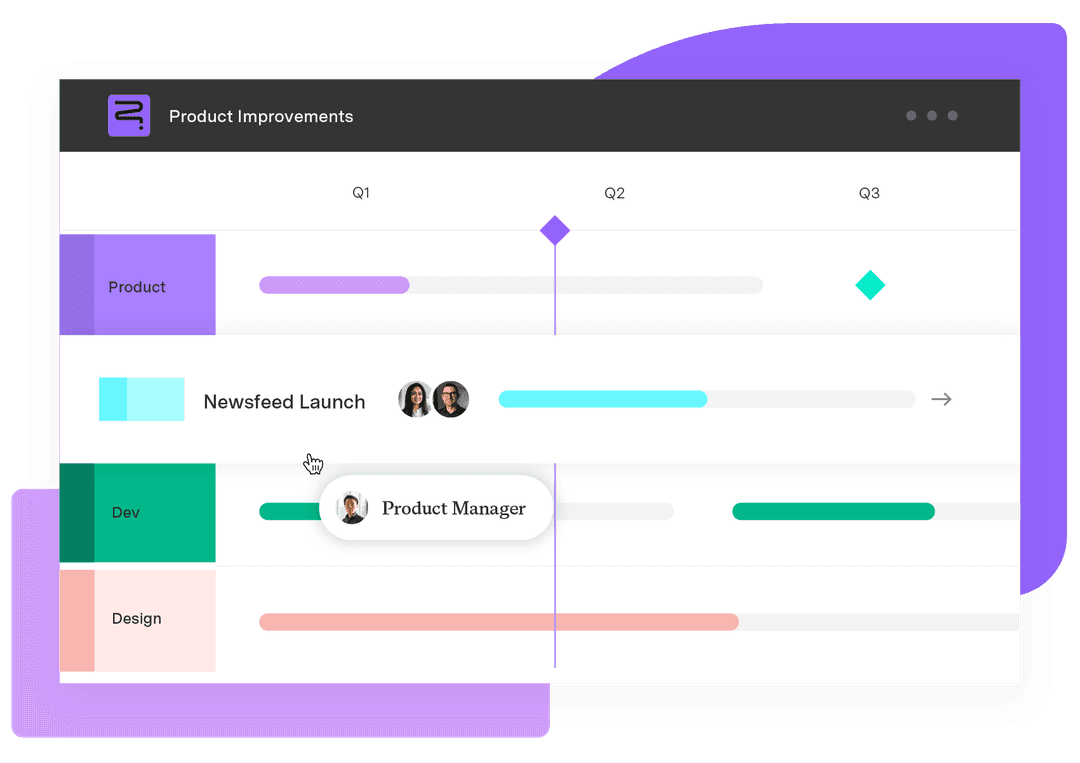What is a project roadmap? Templates and tips
Tempo Team
Successful project management requires clearly defined priorities, careful resource allocation, attainable goals, and effective communication. That’s a lot of plates to spin, but project managers can keep them moving with a single tool: the project roadmap.
Knowing how to write a roadmap is a key project management competency. Here’s everything you should know about execution, plus project roadmap templates to get you started.
What is a project roadmap?
Team leaders use project roadmaps to convey a strategic overview of a project. Roadmaps present a high-level illustration of a project’s primary elements, including:
Project objectives
Milestones
Resources
Deadlines
Deliverables
The visual nature of project roadmaps makes them intuitive – an ideal communication tool for busy stakeholders who are more interested in the big picture than minute details.
Project roadmaps are dynamic, living documents designed to keep team members, management, and stakeholders aware of the work’s evolution. Leaders must regularly update the project management tool to ensure its usefulness, capturing changes to project scope, resourcing strategies, and timelines.
Why do you need a project roadmap?
Roadmap development serves several crucial purposes in project management.
1. Communicates the project’s strategic objectives
Day-to-day conditions and organizational priorities will likely shift throughout a project’s lifecycle. A roadmap allows the project team to adjust while retaining focus on high-level goals. At a glance, it reminds them of the vision behind their work and ensures leaders align every decision with the project’s strategic objectives.
2. Sets expectations
The roadmap also helps stakeholders understand a project’s goals and outcomes, securing management buy-in. Providing status-level progress updates is easier, as leaders can visualize project milestones and financial health.
3. Effectively plan and prioritize
By logically sequencing tasks and milestones, the project roadmap ensures effective resource allocation and directs the team’s efforts toward work with significant impact.
4. Establishes transparency
With tasks and objectives clearly outlined and tracked, team members can easily visualize progress and determine whether the project will meet its goals.
5. Facilitates collaboration
A roadmap creates a shared perspective among stakeholders, enabling discussion regarding project status and scope, deadlines, and outcome adjustments. Leaders can make informed, productive decisions that benefit the group.
6. Identifies project risks
Establishing the roadmap during project planning allows the team to uncover task dependencies and other risks. Then, project management can implement mitigation plans to reduce their likelihood and impact.
7. Ensures adaptability
Roadmaps are dynamic, meaning they can easily adjust to new or changing conditions while maintaining alignment with the project’s original goals.
How to create a project roadmap in 5 steps
With so many free project roadmap templates available online, choosing one can be overwhelming. Whether creating your own or working from a project roadmap sample, follow these steps to ensure success.
1. Define goals and objectives
Roadmap development illustrates the project’s purpose by establishing its objectives and key results (OKRs). These goals should follow the SMART framework: specific, measurable, achievable, relevant, and time-bound. Leadership can use the project plan to expand on the details.
2. Establish outcomes and milestones
Determine the project’s key deliverables based on the defined objectives. Divide the required workflows into project phases and milestones to generate a rough timeline.
3. Outline task progression
Optimize workflows into a logical sequence of tasks based on project priorities and dependencies. Review each workflow for completeness and continuity according to available resources and project timelines.
4. Generate estimates
Next, establish the project schedule and budget. Establish the timeline by estimating completion times for every task within each milestone, including the review and approval process. Calculate the budget based on estimates for direct costs, like materials and labor. Then, combine those amounts with indirect expenses, like overhead, utilities, and professional fees.
5. Illustrate the plan
Finally, bring the roadmap to life to build alignment behind the plan. Graphics will illustrate workflows, deadlines, and interdependencies. For example, a Gantt chart allows stakeholders to visualize task sequences and timing.
This may seem like an intimidating and complex undertaking. Fortunately, project management software simplifies the roadmapping process. Input the information from the previous four steps into a project roadmap template, and your tool will automatically produce an interactive version with a dynamic dashboard that users can peruse to review additional data.
Best practices for project roadmaps
The following best practices will streamline project roadmap development and deliver better results.
Use templates: Even a simple roadmap template can significantly improve outcomes. A template lets project management consistently format roadmaps, ensuring they include all relevant data in an intuitive format.
Involve stakeholders: Incorporating stakeholder input into the roadmap development process fosters collaboration and alignment with project goals.
Establish ownership: Assign the responsibility of updating the project roadmap to a single team member. A lone point of contact to answer questions or address issues ensures consistency and minimizes confusion.
Facilitate feedback: Keep communication channels open to gather feedback and improve the project roadmapping process.
Be realistic: Remain realistic about what the team can deliver to avoid disappointing stakeholders and eroding their trust.
Keep it simple: Limit the project roadmap to high-level visual information to avoid overwhelming stakeholders and facilitate understanding of plans and progress.
Tips for an informative roadmap
Whether you start from scratch or use a template, the following recommendations will ensure you get the most from a roadmap. These tips apply equally to product roadmaps, so don’t feel limited by your industry.
Develop the roadmap first
A roadmap captures the high-level vision for an initiative, illustrating the strategic objectives necessary to create an effective project plan. Once stakeholders agree on goals, you can begin planning how to deliver them.
Use the roadmap to facilitate communication
A project or product roadmap is a powerful communication tool that illustrates goals and the plan for their execution. Use visual details to build alignment and secure buy-in among stakeholders. Your roadmap should also help the team remain on task by ensuring they understand the value of project objectives, priorities, and timelines.
Update regularly
Stakeholders and project team members will likely revisit the roadmap to review goals and monitor progress. Therefore, the document must be updated to accurately reflect the project’s current state. Without pertinent information and regular updates, stakeholders could conclude that the project is stagnating.
A project management tool with roadmapping capabilities simplifies roadmap updates.
Start your project roadmap journey with Tempo
Creating and updating roadmaps is a critical project management practice. Roadmapping ensures that the project team works on the right task at the right time and communicates information to stakeholders in an easily digestible format.
Tempo’s Strategic Roadmaps application has everything you need to bring roadmaps to life, including powerful features like feedback channels, prioritization tools, and visualization options. Tempo also offers users roadmap examples they can customize according to their needs, such as:
If you have the vision, Strategic Roadmaps help you make it a reality. If you prefer Gantt Charts, give Structure PPM a try.










































